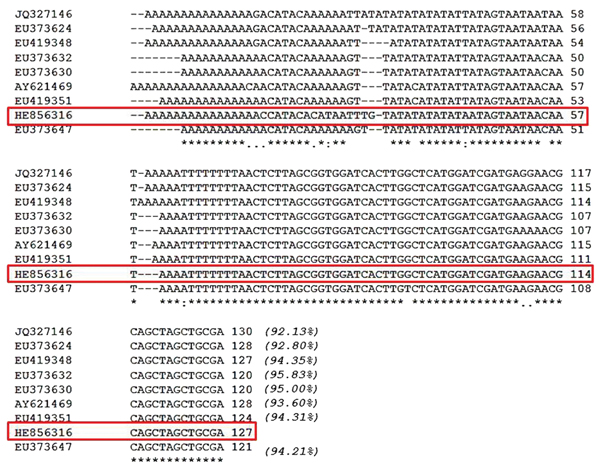Zoonotic Filariasis Caused by Novel Brugia sp. Nematode, United States, 2011
Alberto Enrique Paniz-Mondolfi

, Teresa Gárate, Christine Stavropoulos, Wen Fan, Luis Miguel González, Mark Eberhard, Fred Kimmelstiel, and Emilia Mia Sordillo
Author affiliations: Yale University School of Medicine, New Haven, Connecticut, USA (A.E. Paniz- Mondolfi); St. Luke’s-Roosevelt Hospital Center of Columbia University College of Physicians and Surgeons, New York, New York, USA (A.E. Paniz-Mondolfi, C. Stavropoulos, W. Fan, F. Kimmelstiel, E.M. Sordillo); Servicio Autonomo Instituto de Biomedicina/Instituto Venezolano de los Seguros Sociales, Caracas, Venezuela (A. Paniz Mondolfi); Instituto de Salud Carlos III, Madrid, Spain (T. Gárate, L.M. González); Centers for Disease Control and Prevention, Atlanta, Georgia, USA (M. Eberhard)
Main Article
Figure

Figure. Pile-up of partial ribosomal DNA sequences from Brugia NY strain (HE856316) and from other related Brugia sppstrains and clones, Bmalayi BM28 (JQ327146), Bmalayi C27Cat5 (EU373624), Bpahangi C61CAT5 (EU419348), Bpahangi C14Cat6 (EU373632), Bpahangi C7Cat6 (EU373630), Bpahangi Bp-1 (AY621469), Bpahangi C46CAT5 (EU419351), and Bpahangi C27Cat7 (EU373647)The Brugia NY strain (HE856316) is enclosed in a red box; asterisks (*) indicate conserved residues; periods (.) indicate nucleotide changes; colons (:) indicate nucleotide changes just in the Brugia NY isolate; hyphens (-) are included in the sequences to maximize the comparisons among the 9 DNA moleculesItalicized numbers in parentheses indicate the percentage of similarity with the Brugia NY isolate.
Main Article
Page created: June 18, 2014
Page updated: June 18, 2014
Page reviewed: June 18, 2014
The conclusions, findings, and opinions expressed by authors contributing to this journal do not necessarily reflect the official position of the U.S. Department of Health and Human Services, the Public Health Service, the Centers for Disease Control and Prevention, or the authors' affiliated institutions. Use of trade names is for identification only and does not imply endorsement by any of the groups named above.
